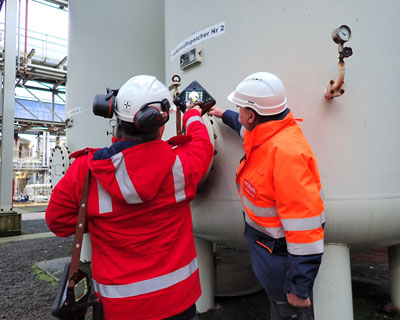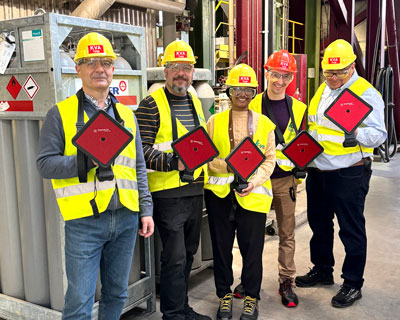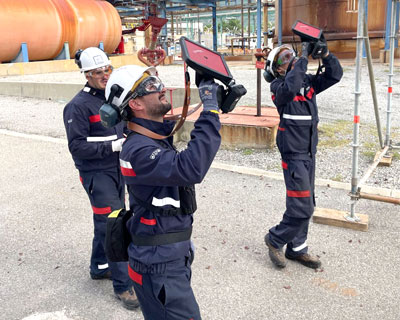Maximize your return on investment
for ultimate leak inspection outcomes
Proper training is essential to ensure precise and reliable measurements.
When you invest in our technology, we make sure you’re never left to figure it out alone.
Our onsite training, led by certified inspectors, ensures your team can fully leverage the power of ultrasound technology.
Why perform onsite training?
Our onsite training equips your team with the expertise and hands-on experience needed to confidently detect leaks even in the most challenging conditions.
Conducted at your premises and tailored to your existing processes, our training ensures seamless integration and maximum reliability in real-world operations.
| Without training | With training |
|---|---|---|
Detect big size leaks | | |
Detect small to medium leaks in quiet environments | | |
| |
|
| |
|
| |
|
| |
|
Obtain reproducible, operator independent results | | |
What our customers say
Training is an investment in long-term operational excellence

“The training was a good mix of theory and practice, and directly enabled us to minimize energy losses. Since then, we regularly use the camera for inspection rounds and tightness checks.”

“We have put 300 employees through the training to confidently use the Distran devices on daily inspection rounds, and ensure it is accessible 24/7 for emergencies.”

“The Distran trainers were excellent— highly knowledgeable, approachable and patient. Our team now finds leaks in unexpected places – where we didn’t think we’d be able to detect them – such as around turbines and in continuously noisy areas.”
Make sure your team is fully equipped to detect leaks with confidence.
Empower your team to inspect with confidence
Our expert-led training equips your team with the confidence and competence to survey the facilities comprehensively.
They’ll be prepared to handle challenging situations and deliver accurate, consistent, and user-independent results.
Browse some real-life scenarios:
–
Adjust the detection frequency settings to discover leaks in noisy areas
WITHOUT TRAINING
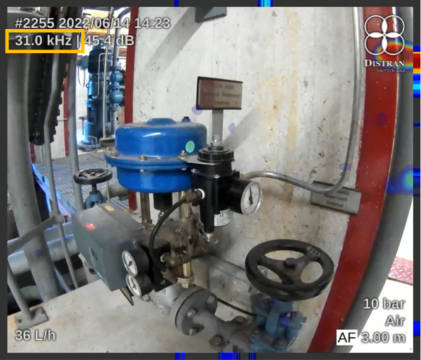
Before training, users rely on default detection settings, which are designed to work across general conditions but may not always be optimized for every unique environment.
WITH TRAINING
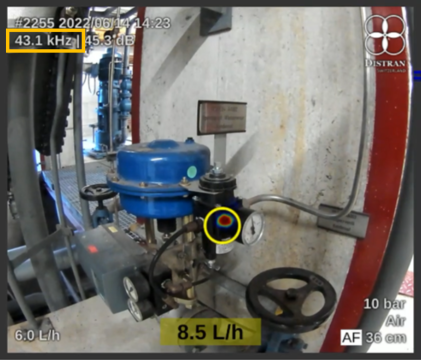
While by using best practices learnt during the training, users adjust the detection frequency based on their specific conditions an uncover an air leak in a pressure regulator that might have otherwise gone undetected.
–
WITHOUT TRAINING

Before training, users rely on default detection settings, which are designed to work across general conditions but may not always be optimized for every unique environment.
WITH TRAINING

While by using best practices learnt during the training, users adjust the detection frequency based on their specific conditions an uncover an air leak in a pressure regulator that might have otherwise gone undetected.
–
Identify hidden leak sources through ultrasound echoes
WITHOUT TRAINING
Without training, operators may see an unusual indication such as the one at the beginning of the video above suggesting a leak on the floor and they may not know how to interpret it. Even if they recognize it as an echo, they are likely to ignore it.
WITH TRAINING
With training, operators interpret ultrasound echoes and use them as a guide during the inspections to help them pinpoint hidden leak sources that otherwise would go unnoticed.
–
WITHOUT TRAINING
Without training, operators may see an unusual indication such as the one at the beginning of the video above suggesting a leak on the floor and they may not know how to interpret it. Even if they recognize it as an echo, they are likely to ignore it.
WITH TRAINING
With training, operators interpret ultrasound echoes and use them as a guide during the inspections to help them pinpoint hidden leak sources that otherwise would go unnoticed.
–
Precisely quantify leak rates
WITHOUT TRAINING
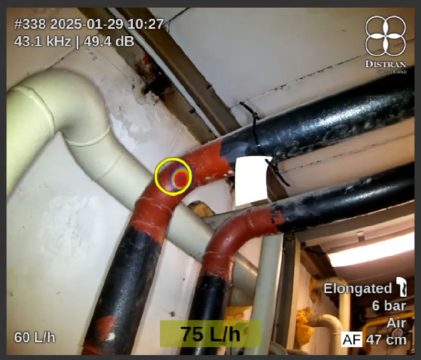
Before the training, operators aren’t aware of how much their positioning affects accurate leak rate quantification, nor how to interpret the results.
WITH TRAINING
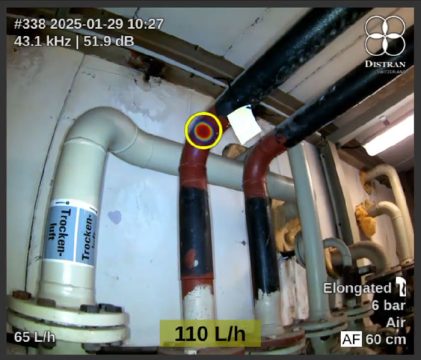
After the training, operators understand the anisotropic sound emission from leaks, and choose the right settings to achieve the most accurate leak rate quantification.
–
WITHOUT TRAINING

Before the training, operators aren’t aware of how much their positioning affects accurate leak rate quantification, nor how to interpret the results.
WITH TRAINING

After the training, operators understand the anisotropic sound emission from leaks, and choose the right settings to achieve the most accurate leak rate quantification.
–
Recognize and filter out other sources of ultrasounds
WITHOUT TRAINING
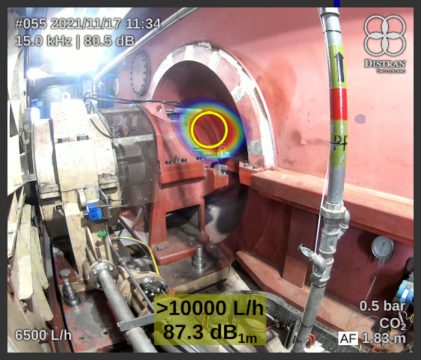
Without proper training, users are likely to select incorrect frequency settings in noisy environments, like the steam turbine example above, resulting in the capture of turbine shaft noise. This can lead operators to misinterpret the noise as a leak, while the actual leak remains undetected and incorrectly located.
WITH TRAINING
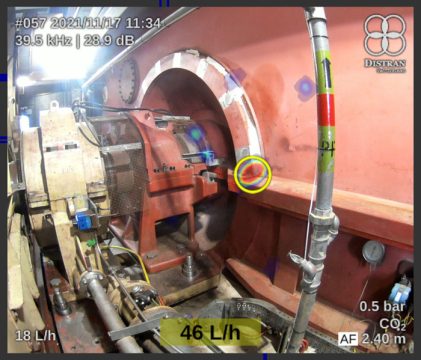
By wisely adjusting the detection frequency, the noise from the shaft rotation is filtered out, Allowing for precise detection of a vacuum leak on a corner split line joint at a steam turbine LP section.
WITHOUT TRAINING

Without proper training, users are likely to select incorrect frequency settings in noisy environments, like the steam turbine example above, resulting in the capture of turbine shaft noise. This can lead operators to misinterpret the noise as a leak, while the actual leak remains undetected and incorrectly located.
WITH TRAINING

By wisely adjusting the detection frequency, the noise from the shaft rotation is filtered out, Allowing for precise detection of a vacuum leak on a corner split line joint at a steam turbine LP section.
Master leak detection in all scenarios.
What is included in the training?
Our onsite training is designed to help you effectively implement leak detection with the Ultra Pro camera by establishing best practices tailored to your needs and current processes.
The training is split into two parts: a theoretical classroom session and hands-on field training.
- The classroom introduction provides a solid understanding of the technology, inspection methods, and reporting techniques, ensuring your team is well-prepared to carry out leak surveys with the Ultra Pro confidently.
- The field training, carried out in small groups of 3-6 people, allows operators to gain hands-on experience, applying the theoretical knowledge in real-world conditions, ensuring they can effectively use the equipment, interpret results accurately, and perform effective leak detection in their specific environment.
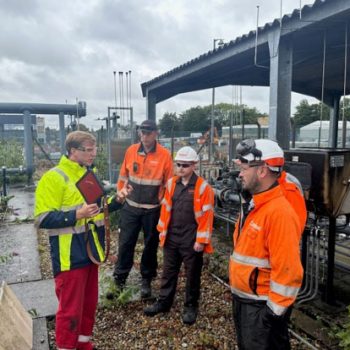
What is included in the training?

Our onsite training is designed to help you effectively implement leak detection with the Ultra Pro camera by establishing best practices tailored to your needs and current processes.
The training is split into two parts: a theoretical classroom session and hands-on field training.
- The classroom introduction provides a solid understanding of the technology, inspection methods, and reporting techniques, ensuring your team is well-prepared to carry out leak surveys with the Ultra Pro confidently.
- The field training, carried out in small groups of 3-6 people, allows operators to gain hands-on experience, applying the theoretical knowledge in real-world conditions, ensuring they can effectively use the equipment, interpret results accurately, and perform effective leak detection in their specific environment.
How can we support you after training?
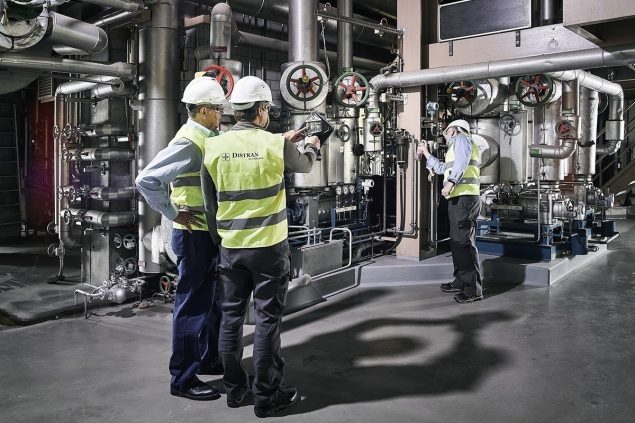
We provide ongoing, personalized support even after your training is complete. Our certified Distran trainers host regular check-in sessions to help with any questions related to implementation or specific use cases. If needed, you can also schedule additional or refresher sessions for both new and experienced camera operators.

How can we support you after training?
We provide ongoing, personalized support even after your training is complete. Our certified Distran trainers host regular check-in sessions to help with any questions related to implementation or specific use cases. If needed, you can also schedule additional or refresher sessions for both new and experienced camera operators.

